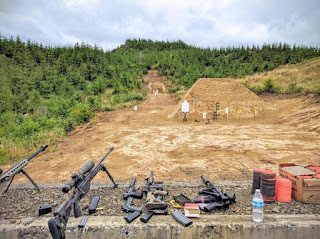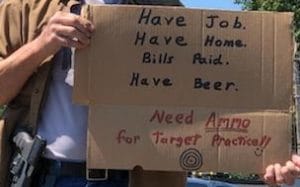Thoughts for consideration when developing improved shooting lanes on public land.
Here are a few thoughts, on last years project, that were designed into the improved shooting lanes in Tillamook State Forest on North Fork Wolf Creek Rd (overseen by Randy Peterson of TSF in Forest Grove, Oregon.
This is the place where Oregon Dept. of Forestry improved 4 shooting lanes. My Vice President Bryan Olson, myself and a couple other knowledgeable recreational shooters, were fortunate enough to consult in the design stages and completion of these lanes.
Your first impression is “Wow! This looks like a nice place to shoot”. And that’s exactly the impression we wanted to give. Make it attractive so people prefer to use this place instead of any old weeded, brush filled or treed place in the forest.
The picture below is a short pistol range, (lane #2). Park in front of the boulders and walk up the gravel path to the Jersey barrier shooting line. There is a soil backstop berm, in front of the big hill, at about 35 yards from the barrier.
Notice the sign! It’s a map of the shooting lane (Lane #3 is about 60 yards long and includes a short pistol berm on the right side). It shows where to locate targets and highlights the No Shoot Zone (around the edges).
Think of a golf course with a map of the hole at each tee. The sign incorporates messages of ODF shooting rules, fire safety and related referral information to Trash No Land and Northwest Firearms. (Be careful not to add too much information. They won’t spend the time to read it!)
Here is a photo of lane #3 before the improvement (trash all over the hillside!). That is very difficult to clean up and rarely ever gets done!
Here’s a picture after the improvement. Since the improvement has been completed, Trash No Land has done 3 cleanups there and each time all the trash was within the shooting lanes! No trash was spread out around the hillside. That made for quick and easy cleanup! Just what we had hoped for! On-going stewardship is happening weekly!
We consistently see targets placed within the lanes. Not outside in the dry grass or brush. This is the primary reason for the design of these lanes. To reduce the potential for wildfire. No dry grass or tinder, not shooting into downed logs/stumps/live trees. Certainly time will tell, however so far, these lanes have out performed the plans we made. They are attractive, inviting, popular, easy to cleanup, promote stewardship and help prevent fires.
A couple more design elements that should be considered…
The shooting line. Yes, Jersey barriers work well, but, double barriers work better! That’s because they are 3 feet apart, filled with gravel, in-between, and have boulders on each end. Why?…
1. To establish a designated shooting line. Shooters no longer need to bring out tables and try to line them up in some fashion that might resemble a shooting line. It’s for shooter safety, convenience and attractiveness!
2. Makes for a nice table top when shooting. We didn’t want the typical scene of a pickup backed in with the tailgate down and all the firearms laid out on the tailgate. What often happens is, the shooter returns to his vehicle, picks up the next gun and sweeps the crowd at the firing line while returning. With a built-in table top, the shooter now brings all his guns to the line and lays them out, pointing down range. We’ve see it over and over again. It’s a natural safety feature! (below photo is Lane 4, about 75 yards).
3. To enter the firing line, you have to walk around the barrier, (not through it). When you do, it’s only natural that you glance across the line and notice if anyone is fondling their firearm. Although “Range Cold” has been called, this is another safety check we had planned on to aide as a double check for no hands on guns while changing targets.
4. Boulder parking. Notice the space between the boulders and shooting line. That was done on purpose. It keeps vehicles just far enough away to deter the idea of working out of your vehicle. You unload and pack your firearms to the shooting line Jersey barrier table top.
5. ADA accessible. A good gravel pack allows for wheel chair access to set up targets. NICE!
6. Promotes user stewardship. Most of those who use these lanes tend to keep them in good condition. Certainly, some do not care and will leave their mess, but for the most part, users are keeping it reasonably picked up. It’s the part about ‘looking like a recreational place’ that helps. Several of our members use this place on a regular basis and report almost weekly on the conditions. Most reports are of only a couple bags worth of trash but in real good condition each week.
Needless to say, I’m excited about these lanes! They have been successful in each area we had planned for. Especially the fire prevention part!
I hope this information helps with your planning efforts and perhaps you could incorporate an idea or two from here.
We all know recreational shooting will be around for years to come. It is tradition and is a viable type of recreation on public land. If we work together in recognizing it’s concerns and potential, we can help shape its future and make it into something that is acceptable to all who visit the forest.
Thank you! I appreciate your work towards improving responsible shooting on public land.
Bill
www.trashnoland.org
A 501(c)3 Charitable Volunteer Nonprofit organization.





 Donate what you can to our General Operating Fund!
Donate what you can to our General Operating Fund!